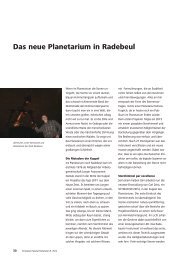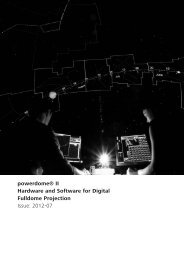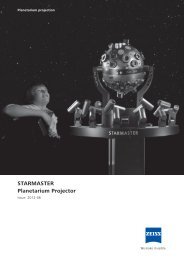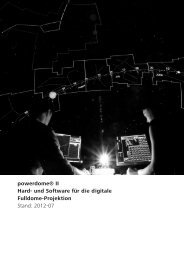Download show flyer - Carl Zeiss Planetariums
Download show flyer - Carl Zeiss Planetariums
Download show flyer - Carl Zeiss Planetariums
Create successful ePaper yourself
Turn your PDF publications into a flip-book with our unique Google optimized e-Paper software.
Funding:<br />
Dark is funded jointly by iVEC, Scitech and iVEC@UWA.<br />
Credits:<br />
Directed by Peter Morse<br />
Produced by Peter Morse & Paul Bourke<br />
Presented by Alan Duffy<br />
Written by Alan Duffy & Peter Morse<br />
Dark Matter Simulations: Alan Duffy and Robert Crain<br />
Dark Matter Visualisations: Paul Bourke<br />
Digital Sky Milky Way Animation: <strong>Carl</strong>ey Tillett<br />
Music: Cathie Travers<br />
Audio: Peter Morse & Trevor Hilton<br />
Lighting: Peter Morse, Ákos Brúz & John Doyle<br />
Fulldome Timelapse: Peter Morse & Chris Henderson<br />
Parkes Panorama: Alex Cherney<br />
Galaxy Animation: Paul Bourke<br />
LadyBug-3 Video: Paul Bourke & Peter Morse<br />
Compute & Network Support: Jason Tan, Ashley Chew,<br />
Khanh Ly (iVEC@UWA)<br />
Galaxy Images Courtesy of Hubble, STScI, NASA<br />
Editing, 3D Modelling, Compositing & Special<br />
Effects, Colour Grade, Fulldome Mastering: Peter Morse<br />
Special thanks to:<br />
<strong>Carl</strong>ey Tillett and Horizon – e Planetarium at Scitech<br />
Paul Ricketts, Centre for Learning Technology, UWA<br />
omas Braunl, UWA Centre for Intelligent Information<br />
Processing Systems, UWA<br />
John Doyle, Octagon eatre, UWA<br />
Andreas Wicenec, ICRAR, UWA<br />
Sally Hildred<br />
©2012 iVEC@UWA & Peter Morse<br />
www.darkthemovie.info<br />
U N D E R S TA N D I N G<br />
DARK MATTER
DARK is a fulldome movie that explains and explores the nature<br />
of Dark Matter, the missing 80% of the mass of the Universe.<br />
e search for Dark Matter is the most pressing astrophysical<br />
problem of our time – the solution to which will help us<br />
understand why the Universe is as it is, where it came from, and<br />
how it has evolved over billions of years – the unimaginable<br />
depths of deep time, of which a human life is but a flickering<br />
instant.<br />
But in that instant, we can grasp its immensity and, through<br />
science, we can attempt to understand it.<br />
DARK is presented by Dr Alan Duffy, a brilliant young<br />
astronomer from the International Centre for Radio Astronomy<br />
Research at the University of Western Australia – who creates<br />
simulations of the universe inside supercomputers - tracing the<br />
way in which Dark Matter evolves from the Big Bang to the<br />
galaxies we see around us today.<br />
Alan introduces us to the idea of Dark Matter, why astronomers<br />
think it exists, and explains why Radio Astronomy is so wellsuited<br />
to its discovery.<br />
We explore why the new Australian Square Kilometre Array<br />
Pathfinder (ASKAP) Telescope, currently under construction in<br />
remote Western Australia, will be so important in this scientific<br />
quest.<br />
But this is only the beginning.<br />
We journey through completely immersive visualisations of<br />
Dark Matter evolution calculated upon some of the world’s<br />
fastest supercomputers – cosmological visions on a truly vast<br />
scale, in which galaxies themselves are but points of light,<br />
distributed across far larger intergalactic structures of Dark<br />
Matter.<br />
ese visualisations demonstrate the cutting-edge of<br />
contemporary supercomputer visualisation of massive scientific<br />
datasets and astrophysical simulation.<br />
It sounds like Science Fiction, but it’s not. It’s the real stuff.<br />
Real Data, seen in this way for the very first time.<br />
DARK is an adventure to the very edges of contemporary<br />
cosmology and data visualisation, telling a complex scientific<br />
story with a touch of humanity.<br />
GIMIC<br />
e formation of a dwarf galaxy from just aer the Big Bang to the<br />
present day - within the larger Dark Matter structure of the Universe.<br />
Gas falls within Dark Matter filaments, part of the larger Cosmic Web,<br />
that provides the gravitational background that structures space.<br />
e gas spins up as it falls deeper into the Dark Matter halo, forming<br />
spiral arms and, eventually, stars at the very centre of the densest,<br />
coldest gas.<br />
KINETIC<br />
An enormously detailed region of the universe around a Dark Matter<br />
halo similar to that of our own galaxy, the Milky Way.<br />
Galaxies and their satellites are caught mid-collapse as they fall along<br />
the Cosmic Web filaments to the centre of the simulation, forming a<br />
catastrophic collision that has all but destroyed the central galaxy.<br />
A similar fate will befall our galaxy when we collide with our<br />
neighbour, the Andromeda galaxy, in approximately 4 billion years.<br />
COSMOS!<br />
UNDERSTANDING DARK MATTER<br />
Dark Matter Visualisations<br />
We see the formation of the very largest structures in the universe<br />
within a Dark Matter simulation that traces the emergence of structure<br />
from an almost perfectly smooth state - just aer the Big Bang - to the<br />
present day.<br />
Dark Matter structures contain thousands of galaxies like our own<br />
Milky Way - which are barely visible bright knots of matter at these<br />
enormous scales.<br />
GIMIC GIMIC II<br />
KINETIC Dark Matter, Gas and Stars<br />
COSMOS COSMOS II
















